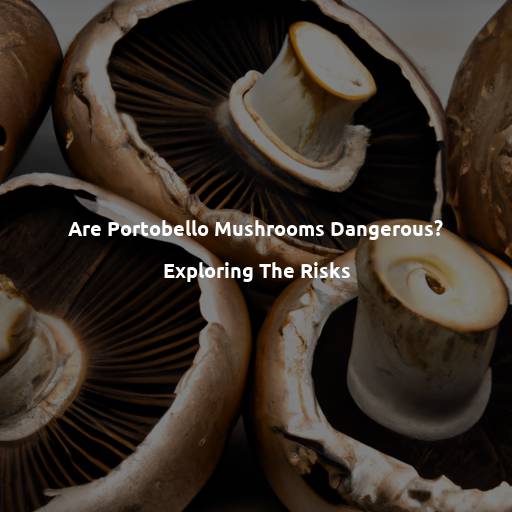Introduction to Portobello Mushrooms
Portobello mushrooms, also known as Agaricus bisporus, are a popular choice among mushroom enthusiasts and culinary experts alike. These hearty fungi are characterized by their large, flat caps and meaty texture, making them a versatile ingredient in a wide range of dishes. From grilled portobello burgers to savory mushroom stews, the possibilities are endless when it comes to incorporating these flavorful mushrooms into your cooking repertoire. While portobello mushrooms are generally safe for consumption, it is important to be aware of any potential risks or toxicity concerns. In the following sections, we will delve deeper into the various aspects of portobello mushroom safety, including their toxicity risk, potential health risks, identification of poisonous look-alikes, safe preparation methods, and ultimately, how to enjoy portobello mushrooms in a safe and delicious manner.
Toxicity Concerns: Are Portobello Mushrooms Poisonous?
Portobello mushrooms are an incredibly popular choice for mushroom enthusiasts. However, some individuals may have concerns about the potential toxicity of portobello mushrooms. In this section, we will explore whether or not portobello mushrooms are poisonous and provide fact-based information to alleviate any concerns.
To put it simply, portobello mushrooms are not poisonous. They are considered safe for consumption when properly prepared and cooked. In fact, they are widely recognized as a nutritious and delicious addition to various dishes.
It is important, however, to distinguish between portobello mushrooms and their poisonous look-alikes. While portobello mushrooms themselves are not toxic, there are certain mushrooms that resemble them and can be harmful if consumed. This is why it’s crucial to be able to differentiate between edible portobello mushrooms and their poisonous counterparts.
If you are unsure about the mushrooms you have found or purchased, it is always recommended to consult an expert mycologist or a trusted source for proper identification. Mistaking a poisonous mushroom for a portobello mushroom can lead to potentially dangerous consequences.
In conclusion, portobello mushrooms are safe and non-poisonous when prepared and cooked correctly. By familiarizing yourself with their distinctive characteristics and taking precautions, you can enjoy the unique flavor and nutritional benefits of portobello mushrooms without any worries.
Potential Health Risks of Portobello Mushrooms
Portobello mushrooms, known for their rich flavor and meaty texture, are a popular ingredient in various culinary dishes. While they offer several health benefits, it is important to acknowledge the potential health risks associated with consuming Portobello mushrooms.
One potential health risk of Portobello mushrooms is the presence of allergens. Some individuals may experience allergic reactions such as itching, swelling, or difficulty breathing after consuming these mushrooms. It is recommended to consult with a healthcare professional if you suspect an allergy or have a history of allergies.
Another health risk to consider is the potential for foodborne illnesses. Like any other type of mushroom, Portobello mushrooms can be contaminated with harmful bacteria, such as E. coli or Salmonella. These microorganisms can cause food poisoning, leading to symptoms like nausea, vomiting, diarrhea, and abdominal pain. To reduce the risk of foodborne illnesses, it is crucial to purchase Portobello mushrooms from reputable sources and ensure proper storage, handling, and cooking.
Additionally, Portobello mushrooms contain a compound called agaritine. Although agaritine is naturally present in many mushrooms, studies have suggested that it may convert into a potential carcinogen called hydrazine during cooking and digestion. However, the levels of agaritine in Portobello mushrooms are relatively low, and the link between Portobello mushroom consumption and cancer risk in humans is not well-established. Nevertheless, it is advisable to consume Portobello mushrooms in moderation and include a diverse range of fruits and vegetables in your diet for overall health.
It is important to note that proper preparation and cooking methods can significantly reduce the potential health risks associated with Portobello mushrooms. Ensure that you thoroughly wash and inspect the mushrooms before cooking. Cooking Portobello mushrooms at temperatures above 160°F helps destroy harmful bacteria and can also neutralize some of the agaritine content.
In conclusion, while Portobello mushrooms offer delicious taste and nutritional benefits, it is essential to be aware of the potential health risks associated with their consumption. Allergies, foodborne illnesses, and the presence of agaritine are important factors to consider. By practicing safe food handling, cooking at appropriate temperatures, and consuming Portobello mushrooms in moderation, you can continue to enjoy them as part of a healthy and varied diet.
Understanding Poisonous Look-Alikes
Mistaking poisonous mushrooms for edible ones can have serious consequences. It is important for mushroom enthusiasts to be able to accurately identify portobello mushrooms and understand the key differences between them and their poisonous look-alikes. Here are some common poisonous mushrooms that may be mistaken for portobellos:
1. Death Cap (Amanita phalloides): The death cap is one of the most toxic mushrooms out there. It closely resembles young portobello mushrooms in appearance, with a similar shape and color. However, there are a few distinctive features that can help differentiate them. Death caps have white gills, a skirt-like ring on the stem, and a cup-like structure at the base.
2. Destroying Angel (Amanita bisporigera): Another deadly mushroom, the destroying angel, also bears a resemblance to portobellos when young. It has a white or off-white cap, white gills, and a smooth stem. Unlike portobellos, destroying angels have a sac-like volva at the base of the stem.
3. False Morels (Gyromitra species): False morels have a wrinkled or brain-like cap that may look similar to the irregularly-shaped cap of a mature portobello mushroom. However, false morels are highly poisonous and should never be consumed. True morels, on the other hand, are safe and highly sought after.
4. Panther Cap (Amanita pantherina): The panther cap is another toxic mushroom that can be mistaken for portobellos, especially when young. It has a brownish cap with white or yellowish speckles and white gills. The stem may have a ring or partial veil.
When foraging for mushrooms or purchasing them from farmers’ markets, it is essential to have a good understanding of these poisonous look-alikes to avoid any potential health risks. It is recommended to consult expert mycologists, field guides, or attend mushroom identification workshops to improve your knowledge and skills in differentiating between edible mushrooms, like portobellos, and their potentially harmful counterparts.
Safe Preparation and Cooking Methods
Portobello mushrooms are not considered dangerous when properly prepared and cooked. To ensure the safety and enjoyment of these flavorful fungi, follow these safe preparation and cooking methods:
1. Cleaning: Start by gently wiping off any visible dirt or debris from the mushroom caps using a damp paper towel or soft brush. Avoid washing them under running water as they are porous and can absorb excess moisture.
2. Removing the gills: While not necessary, some prefer to remove the gills from the underside of the mushroom caps to create more space for stuffing or toppings. Use a spoon to gently scrape away the gills, being careful not to damage the cap.
3. Marinating: Enhance the flavor of your portobello mushrooms by marinating them before cooking. Create a simple marinade using olive oil, balsamic vinegar, garlic, and herbs. Allow the mushrooms to soak in the marinade for at least 30 minutes to infuse them with delicious flavors.
4. Grilling: Portobello mushrooms are excellent candidates for grilling due to their meaty texture. Preheat your grill to medium-high heat and lightly oil the grates to prevent sticking. Place the mushrooms on the grill, cap-side down, and cook for approximately 4-5 minutes per side until tender and slightly charred.
5. Sautéing: Heat a drizzle of olive oil or butter in a skillet over medium heat. Add the portobello mushrooms, sliced or whole, and cook for about 5-7 minutes, stirring occasionally, until they are tender and have released their moisture.
6. Baking: Preheat your oven to 375°F (190°C). Place the marinated or seasoned portobello mushrooms on a baking sheet lined with parchment paper. Bake for approximately 20-25 minutes or until they are fork-tender.
Remember to cook portobello mushrooms thoroughly to ensure safe consumption. The internal temperature should reach 160°F (71°C) to kill any potential harmful bacteria. Enjoy your cooked portobello mushrooms in various dishes like burgers, salads, sandwiches, or as a side dish.
By following these safe preparation and cooking methods, you can confidently enjoy the deliciousness of portobello mushrooms without any safety concerns.
Conclusion: Enjoying Portobello Mushrooms Safely
In conclusion, while portobello mushrooms are generally safe for consumption, it is important to be aware of potential risks and take necessary precautions. By properly identifying portobello mushrooms and distinguishing them from poisonous look-alikes, you can avoid any dangerous consequences. Additionally, it is crucial to be mindful of potential health risks, such as allergies and foodborne illnesses, and to practice safe food handling and proper cooking methods. Remember to thoroughly wash, inspect, and cook portobello mushrooms at appropriate temperatures to reduce the risk of harmful bacteria. By following these guidelines, you can confidently enjoy the unique flavor and nutritional benefits of portobello mushrooms in a safe and delicious manner.

